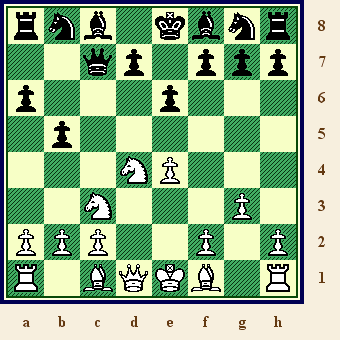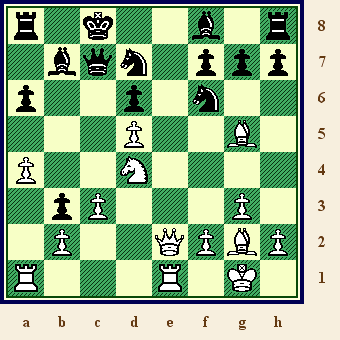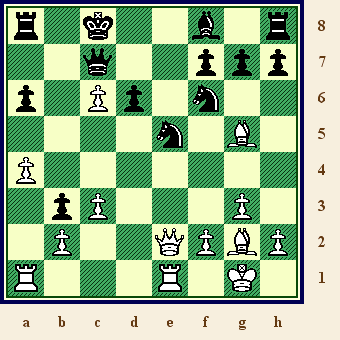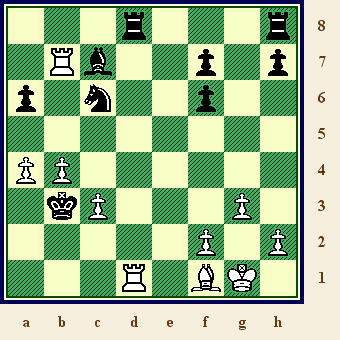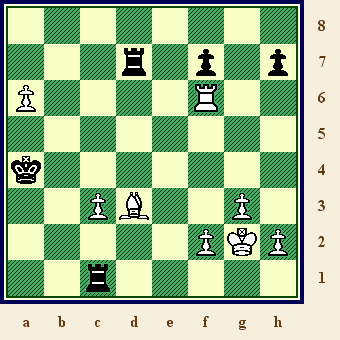GM
Leonid Z. Stein (2688) - GM
Seymon A. Furman (2606)
[B43]
The 37th National
(URS) Championships (Crosstable)
Moscow, U.S.S.R. / (Round
# 18), 09/1969.
[A.J. Goldsby I]
This is one of the games that are in the new book by
GM Garry Kasparov.
("My Great Predecessors," Part III.) {Game # 68, page # 253.}
I was familiar with this game ... having analyzed this contest - for some reason - several years before.
I chose this game almost at random, I thought it would be interesting to subject Kasparov's work to a
deep analysis with the computer ... and see how many errors I could possibly find. (I also had a few
ideas written down in a notebook about this game ... they had not been checked in over 15 years.
I had to see if they were any good.)
***************************************
The ratings come from the website of the chess statistician.
Jeff Sonas. (To get ratings that are
comparable to today's numbers, one would probably have to add at least fifty points to both
parties here.)
1.e4 c5;
2.Nf3 e6;
3.d4, (Maybe - '!')
While the "Open Variation" may
not be to everyone's taste, it is proven and time-tested.
(Other systems will not guarantee an edge or initiative for White.)
[ The position after the moves:
3.Nc3 a6; 4.g3 Nc6;
5.Bg2 Qc7; 6.0-0 b5;
7.d4 cxd4; 8.Nxd4 Bb7;
9.Re1 d6; 10.a4! b4; 11.Nd5!! Qa5; 12.Nxc6!,
12...Bxc6; 13.Qd4!,
"+/=" (Maybe - '±') {Diagram?}
... White is clearly better and won easily. This position has been seen in several
master games, but the first was the following struggle:
GM R. Reti - GM S. Tartakower; Match Game, 1919. (!!!)
{Source = GM Raymond D. Keene} ]
3...cxd4;
4.Nxd4 a6;
Black plays an early ...a6 line in the Paulsen Sicilian. This system was a favorite of Tigran Petrosian,
to name perhaps the most famous practitioner of this whole system.
5.Nc3 Qc7!?;
A common line, but criticized by Kasparov and company.
[ Also possible was:
5...Nc6!?
]
6.g3,
(Maybe - '!')
A solid system, [g3 versus any line in the Paulsen Sicilian]; and a solid favorite of positional-minded
players. (Fischer beat Tal in this system at Bled. See Fischer's book of games.)
[ The other main try is:
6.Be2,
"+/=" {see any good reference work}. ]
6...b5!?;
(Maybe - '?!')
{See the diagram - just below.}
A radical move ... but not necessarily unsound here. ('?' - GM G. Kasparov)
*********************************************
*********************************************
Kasparov roundly condemns this move, assigning a whole question mark.
(But I feel that this is reactionary and far from correct here.) Indeed, this system is popular today ...
with GM's [again] playing an early b7-b5; as Black. {Study a few of the games from the recent
2004 FIDE Championships in Tripoli, Libya; 2004.}
Anyone who is interested can go to my main website for downloads -
http://www.angelfire.com/games3/AJs01Downloads/index.html.
{See the downloads page.}
There I have annotated all
the games from the 2004 Finals Match between
GM M. Adams
and GM Rustam
Kasimzhanov. This also includes a fairly detailed look at the opening.
Also I should note that I gave this position to Fritz 8.0 for over an hour, it only awarded
a tiny edge to White.
[ By far, the most popular move for Black in this position is:
6...Nc6;
('!?')
(statistically speaking). ]
7.Bg2 Bb7!?;
8.0-0, "+/="
White has a slight edge ... but nothing too terribly serious here.
"Strangely enough, it is already hard to offer Black any good advice."
- GM Garry Kasparov and company. (MGP, 3)
The very strong program, Deep Junior, only sees a very small edge for White after more
than 30 minutes of machine time ... to 'cogitate' in this position.
[ Interesting and playable was:
8.a3!?, for White in this position.
]
8...Nf6?!;
(Maybe - '?')
A distinctly inaccurate move ... that is not even questioned by Garry.
(Black had to play ... b5-b4;
in this position. As the course of this contest clearly shows,
Black must play this move in BEFORE White is able to play Re1!)
Garry's complete failure to pinpoint the losing move ... (and find substantial improvements),
are fairly significant in a book that has been trumpeted as ... "the final word
...
{read = best analysis}
on the history of chess, by the world's greatest player."
(False advertising?)
[ A big improvement was:
(>/=) 8...b4[]; ('!')
9.Nce2!?,
{Diagram?}
Probably the most natural square. (I do not think that the sacrifice of
Nd5 will work in this position ... it is not one the box's top 3 or 4 move
choices. I looked at it briefly, Black's position is just too flexible.)
( The box [Fritz]
prefers:
(</=) 9.Na4!? Nf6; 10.Re1 h5!?;
"<=>" {Diag?}
with wildly unclear play. )
9...Nf6; 10.Qd3
d5!; "=" ("=/+")
{Diagram?}
Black seems to have no problems in this position.
See the contest:
Vadim Nikolaev - Vladimir Karasev;
"White Nights" Open
/ St. Petersburg, RUS; 2002.
{Black won a relatively long game.}
]
White's next move is excellent ... and sets up the coming sacrifice.
(Kasparov - also - awards this move an exclamation point.)
9.Re1! d6!?;
(hmmm)
This does not help Black ... and even might makes things worse.
{Again, Black needs to play ...b5-b4;
and the sooner, the better.}
White's next move is an improvement is an improvement over previous play says
Grand-Master Ray Keene.
10.a4!, (line-opening)
Prior to sacrificing a Knight on d5, White follows the classic Morphy formula to expose
Black as much as possible.
[ After the moves:
10.f4!? b4; 11.Na4!?,
"~" {Diagram?}
... the position is rather vague.
(Fritz 8.0 cannot make up its mind who is better, as a master,
I would say the position is relatively balanced.)
************************************************************
After the following moves:
(</=)
10.Nd5!? exd5; 11.exd5+ Kd8;
12.Bg5 Nbd7; 13.c4,
"~" {D?}
White had a strong attack ... and eventually won the game, but only after
some very spotty play by the second player.
Khorberg - Alexander Kotov;
Telegraph game / SVD /
1959. ]
10...b4!?;
11.Nd5!!,
IF this sack is correct - and I am not 100% convinced that it is sound -
then it is certainly VERY brilliant! ({only} '!' - GM Garry
Kasparov.)
"No other move is worth consideration, at this point." - GM R. Keene
(I don't really buy this statement.)
[ {also} Possible was:
11.Na2!?,
"+/=" and White will follow with c2-c3,
opening the game with a small advantage ... due to the first player's lead
in development. ]
Black's next move is virtually forced, Kasparov's book demonstrates that all the alternatives are worse.
11...exd5!;
12.exd5+ Kd8[];
This is completely forced for Black in this position.
[ A very plausible line, but one that shows how quickly Black can lose, would be:
</= 12...Be7?; ('??')
13.Nf5 Ng8?!; 14.Bg5! f6?;
15.Nxg7+ Kf7!?; {Diag?}
The most natural-looking move, at least for a handful of students that I tested this
position on. (Maybe - '?')
*****
( Better is the continuation of:
(>/=) 15...Kd7; {Diagram?}
Is Black safe here? (No.)
After the simple moves: 16.Qg4+ Kd8; 17.Ne6+, {D?}
Black loses the Queen. ("+/-") )
*****
16.Ne6 Qd7!?;
('?') {Diagram?}
There is no real defense ... Black can prevent the mate ...
only by surrendering the Queen. {That would also be hopeless.}
17.Qh5#.
]
13.Bg5 Nbd7!?;
(Maybe - '?!')
This does not really help Black, at least not that much.
(Garry - - and friends - show that ...Be7; and also ...Bc8;
also are of no real help to
Black's cause ... and even might make things worse.)
My original idea ... when I first looked at this game quite a number of years ago ...
was for Black to play "Queen-to-c5" in this position. And I never found a complete
refutation of that particular idea. {Black's King needs a good hiding square.}
[ Possible was:
13...h6!?;
{Diagram?}
which might be better than the continuation which
was actually chosen in the game.
*******************************************
The best defense probably was:
>/= 13...Qc5!?;
"~" (Maybe - '!')
{Diag?}
with relatively good play for Black. ]
Now Fritz clearly indicates that the move (Nc6+!) I originally chose here is probably the best for White,
but the move chosen by Stein is also good. {Fritz also prefers Nc6 on move fifteen as well.}
14.Qe2!? Kc8;
I am not at all sure about this particular move for Black. ('?!')
(Fritz finds an improvement ... and it takes less than one minute to do so.)
[ Better was:
>/= 14...Qb6!;
"~" {Diagram?}
when the box sees no real
advantage at all for White.
Now Kasparov and company give:
15.c3! Ne5!?; 16.a5!? Qc5;
17.Nc6+!? Kc8??; {Diagram?}
This is simply a blunder ... every program I checked confirmed that
Black had to capture on c6 here.
( An obvious improvement would be:
>/= 17...Bxc6[]; 18.dxc6 Be7; 19.cxb4!?
Qb5!, "<=>" {D?}
when it is not even clear if White can win from this position.
)
18.Be3 Qb5; 19.Bh3+ Nfd7;
20.Bxd7+ Kxd7?!; 21.Nxe5+ Kc8?;
(Taking the Knight ... was more
or less forced.)
22.c4!,
("+/-") {Diagram?}
Black is lost and resigned. (1-0)
GM Ilia Smirin - GM Boris Gelfand;
ICT / Masters /
Sverdlovsk, USSR; 1987.
***
*** ***
But definitely NOT:
</= 14...h6??;
('???') 15.Qe8#.
]
*********************
Kasparov gives White's next move, (c2-c3); an exclam ('!') ... but as to why, I have not a clue.
{It appears to be the ONLY real way of continuing the attack.}
15.c3 b3!?;
(Probably - '?!') {See
the diagram ... just below.}
This move appears to be an error, but Kasparov and company do not really seem to notice.
(Maybe even - '?')
*********************************************
*********************************************
"Also after 15...h6; 16.Bxf6, Nxf6; 17.cxb4, White's attack can hardly be parried."
- GM Garry Kasparov (In "My Great Predecessors,
Part III.") [curious?]
After this move ... nearly all the programs that I tested this game on, see a dramatic shift,
(One to two whole points!!); in their respective evaluations of the key positions.
[ After the move:
>/= 15...Qc5!?;
('!') {Diagram?}
White still has a strong attack ... but this appears to be a very significant
improvement over the game.
*******************************************************************
But definitely not:
</= 15...bxc3?;
{Diagram?}
It is almost always incorrect to open lines in the defense of a distinctly inferior game.
16.Rac1 Bxd5; 17.Rxc3 Nc5;
18.Bxd5 Nxd5; 19.Qf3!, "--->"
{Diagram?}
and since Black cannot properly protect the Knight on the d5-square, (Not ...Qb7?
because of Re8+, winning.); White regains the piece with a winning
("+/-")
attack from this position. ]
16.Nc6!,
('±')
"Thematic," says Garry Kasparov.
This is easily the best, although Kasparov (and company) spend a lot of time
analyzing Qe8+!? here for White.
[ Interesting was:
16.Ra3!?, "+/="
{Diagram?}
with very good play for White.
*****************************************
Kasparov - and company - give:
16.Qe8+!? Qd8!; 17.Qxf7!? Ne5;
{Diagram?}
Fritz agrees that this is forced.
( Not </= 17...h6?; 18.Nc6!, "+/-"
)
18.Rxe5! dxe5; 19.Bh3+ Kb8;
20.Nc6+ Bxc6; 21.dxc6,
21...Ra7!?;
22.Qxb3+ Ka8; 23.Rd1!,
('±') {Diagram?}
as winning ("+/-") for White.
{A wild and interesting line.} ]
16...Bxc6;
{Box!}
This is absolutely forced for Black in this position.
[ Much, much worse would be:
</= 16...Ne5?;
17.Bxf6! gxf6?; {Diagram?}
as now Bh3+! will cost Black his Queen, (and then some!).
White is clearly winning. ("+/-") ]
17.dxc6!?,
('?!')
This wins, (routinely) ... BUT ...
{White had a much better move!}
The really curious thing is that Kasparov and company makes NO comment at all here!
If I adhered to the modern school of chess annotation, (as Kasparov seems to); ... then I
would have to give the last move a whole question mark.
[
A HUGE (!!!!!)
improvement is:
>/= 17.Qe8+!!
Nxe8[]; {Diagram?}
This is absolutely forced for Black.
( But absolutely not: </= 17...Kb7??;
18.dxc6+ Ka7[];
19.cxd7!, ("+/-") winning for White.
** ** ** ** ** ** ** ** ** **
** ** ** ** ** ** ** ** **
Also bad for Black would be:
</= 17...Qd8?!; ('?') 18.Qxd8+ Kxd8;
19.dxc6 Rb8;
20.cxd7 Kxd7; 21.Bxf6 gxf6; 22.Bd5,
'±±' ("+/-" ?)
{and} Black's position is in ruins.
)
18.Rxe8+ Kb7;
('!?') {Diagram?}
Seemingly forced ... the box says that Black should give back the
Queen
here, but few human players would find this a really attractive course.
( Probably a little better is:
>/= 18...Qd8!; 19.Rxd8+ Kc7;
20.dxc6 Rxd8; 21.Bxd8+ Kxd8; 22.cxd7 Kxd7;
23.Ra3, '±' {Diagram?}
White is much better ... several programs consider this to
be a completely won ending ("+/-")
for White. )
19.dxc6+ Kb6;
{Diagram?}
This looks forced ... although most programs prefer another move for Black in this position.
Once more ... the box says that Black should return the Queen in this position. (I sent this
position out to many of my Internet students. The ones that responded all said that ...Kb6;
appeared to be the most natural move here for Black.)
( After the moves:
>/= 19...Qxc6[]; 20.Bxc6+ Kxc6;
21.Rxa8, ("+/-") {Dm?}
Black is down a whole exchange, and stands to lose even more
material from here. )
20.cxd7! Qxd7;
{Diagram?}
Black has no choice.
( Even worse would be:
</= 20...Be7?!; 21.Be3+ Ka5;
22.Bxa8, ("+/-") winning easily. )
21.Rxa8,
("+/-") {Diagram?}
Any program will confirm that Black cannot adequately defend his King from this position.
{A.J.G.}
GM Garry Kasparov ... (and various friends and analysts?) ... misses this move completely!
(THERE IS ABSOLUTELY
NO EXCUSE FOR THIS AT ALL!!!)
I tested literally dozens of programs on this position, and even a few dedicated micro-processor
units as well. ALL of them found the move of Qe8+!, without too many problems or delays. ]
Black's next move is forced ... otherwise the second party will be swept right off the board.
17...Ne5[];
{See the diagram ... just below.}
Any other move will lose horribly.
*********************************************
*********************************************
The only question now is ... what is the best way for White to proceed from this particular position?
[ After the following continuation ... which was originally suggested by a fairly strong
{Internet} student of mine, Black gets (quickly) rolled off the board.
</=
17...Ra7?!; ('?') 18.cxd7+ Qxd7;
19.Qc4+ Qc7; 20.Qxb3,
{Diag?}
White is only up one Pawn ... but the current version of Hiarcs considers White to
be winning, ("+/-");
... by nearly three points.
(Black is hopelessly behind in his development, and the King is also {permanently?}
trapped in the middle of the chess-board.)
]
White to play ... what move would you choose here?
18.Ra3!?,
(Maybe - '?!')
'!' - GM Garry Kasparov and company.
This move is traditionally given a an exclamation point here ... and Garry follows suit.
(But other than the exclam, he gives no commentary at all here for this move.)
Bh3+! appears to be yet another fairly major and significant improvement over the course of
the actual game. (The move of Bh3+! is also yet another move that was missed by GM Garry
Kasparov - - - and company.)
[ Much better would have been:
>/=
18.Bh3+! Kd8;
{Diagram?}
This appears to be forced here.
( After </= 18...Kb8?; 19.Ra3!, Black is lost. ("+/-")
)
All of the remaining moves of this variation look to be forced, or at the very least - best.
19.Rad1! h6!?; 20.Bxf6+ gxf6;
21.f4 Qa7+; 22.Kh1 Nxc6;
23.Qe8+ Kc7;
24.Qxf7+ Kb6;
25.Qxb3+ Kc7; 26.Qc4!,
"--->" ('±') {Diagram?}
About two hours of careful analysis, aided {of course!} by the computer,
clearly shows that Black will be unable to hold this position.
("+/-")
{White's threat after Qc4 is to simply play b4-b5. Black is nearly helpless against this idea.} ]
18...d5?;
(Ugh!)
In actuality ... this is the losing move.
{Although a very old book that I have on Stein - fails to point this out.}
[
The try of: >/= 18...Rb8[];
{Diagram?}
('!' - GM Garry Kasparov)
... "was much more tenacious." ]
19.Rxb3 Bd6;
20.Bxf6 gxf6; 21.Bxd5 Nxc6; 22.Qg4+!?,
Kasparov awards this move an exclam, ('!') but it seems that White had yet another improvement,
over the course of the actual game, at this point in the struggle.
'!' - GM Raymond D. Keene
'!' - GM Garry Kasparov
[ Another
big improvement is:
>/= 22.Be4!! Ra7;
{Diagram?}
This looks to be virtually forced.
***********************************************************
( Even worse would be:
</= 22...f5?; 23.Bxf5+ Kd8;
24.Qd3 Rb8; 25.Rxb8+ Qxb8;
26.Rd1 Ke7; 27.Qe3+! Ne5; 28.f4,
"--->" ("+/-") {Diag?}
with an attack that will win the game quite easily for White.
*** *** *** *** *** *** *** *** *** ***
*** *** *** *** ***
Also no fun for Black was:
</= 22...Rb8?; 23.Qxa6+ Kd8; 24.Rxb8+ Nxb8;
25.Qd3, "+/-"
White has three strong Pawns for the piece ... and Black finds it
impossible to co-ordinate his remaining forces here.
*** *** *** *** ***
*** *** *** *** ***
*** *** *** *** ***
Also very bad for Black would have been the continuation:
</= 22...Rg8!?; ('?!') 23.Rd1! Na5!?; {Diagram?}
There is really nothing for the second party that is any better.
(Most continuations - like ...Rb8;
- are similar to what has been
analyzed in other variations.)
24.Bxa8 Nxb3; 25.Bd5 Na5;
26.Qxa6+ Kd7; 27.Qb5+! Ke7[];
28.b4, ("+/-") {Diagram?}
White is winning, the Black Knight has no squares here.
(If ...Rb8; then simply Qe2+.) )
***********************************************************
Returning to the main {analysis} line from here.
23.Qg4+ f5!?;
{Diagram?}
The box gives this as forced.
( After the moves:
</= 23...Kd8?; 24.Bxc6 Qxc6; 25.Qd4, ("+/-")
{Diag?}
White is clearly winning. )
24.Qxf5+ Qd7;
{Diagram?}
This is forced as well. If 25...Kd8?; then simply Bxc6 and Qf6+,
which forks the King and Rook.
25.Rb6!?,
(hmmm) {Diagram?}
This wins of course, and one of the programs I was analyzing with
chose this line.
( Also very good for White would be the following continuation:
(>/=)
25.Qd5, ('!') 25...Ne7; 26.Qxf7, '±' {Diagram?}
when White is clearly a whole lot better, and possibly even
winning ("+/-") in this position. )
25...Qxf5; 26.Rxc6+ Kd7; 27.Rxd6+ Kxd6;
28.Bxf5, '±±' {D?}
This is a substantial improvement over the course of the game. Black's
position is a complete wreck, his King is sadly exposed, and White has
THREE Pawns AND a good, very active Bishop for the exchange.
(All the programs agree that White should be winning
{"+/-"} here.) ]
22...Qd7;
23.Qxd7+!,
The simplest says Garry Kasparov, (who also awards an exclam here);
although Fritz 8.0 prefers Qc4 here by over half a Pawn. (!!)
[ After the moves:
(>/=)
23.Qc4 Kc7; 24.Rd1 Rhd8; 25.a5,
'±' {Diag?}
White is clearly better. (Maybe just winning?)
]
23...Kxd7;
24.Rb7+ Bc7[]; 25.Bg2!, ('!!')
(nice)
Definitely the best ... and also the first choice of Fritz as well.
"With the murderous threat of Rd1+ here for White," says Garry Kasparov.
[
</= 25.b4?
Rab8; "~" ]
25...Rad8;
This appears to be forced here.
[ MGP(3) gives the continuation:
</= 25...Rhd8?;
26.Rd1+ Kc8; 27.Rxd8+ Kxd8;
{Diag?}
No choice for Black here.
*******
( </= 27...Kxb7?; 28.Bxc6+ Kxc6;
29.Rxa8, "+/-" {Diag?}
and wins easily.
**
**
**
**
**
**
**
** **
Or </= 27...Nxd8?!; 28.Rxc7+ Kxc7;
29.Bxa8, ("+/-") {D?}
also with a hopeless endgame. )
*******
28.Bxc6,
("+/-") {Diagram?}
and White, who is two Pawns ahead, wins easily - despite the presence of
opposite-colored Bishops here. ]
26.Bh3+! Kd6[];
27.Rd1+ Kc5; 28.b4+ Kc4; (hmmm)
Are we going to have a King-hunt ... in what is virtually an end-game?
29.Bf1+ Kb3;
{See the diagram ... just below.}
This is a very interesting position that we now have ...
White's next move is very critical in determining the outcome of this struggle.
*********************************************
*********************************************
Take a look, and see what you think. I challenge all the players out there who are interested to
set up this particular position on your computer and analyze it for yourself.
30.Rxc7?!,
(Probably - '?')
Definitely not the most accurate move for White in this position, ...
(despite what Garry and friends say about this particular play).
[ Kasparov says that Rb1?! was inaccurate, and gives the following analysis
continuation here: (>/=)
30.Rb1+ Ka2; 31.Rxc7 Ne5!; 32.f4! Kxb1;
33.fxe5 fxe5;
34.Bxa6 Kc2!?; 35.a5 e4!?; {Diagram?}
... "the situation would have become sharper."
- GM Garry Kasparov.
{Garry ends his analysis line here.}
But sharper does not necessarily mean worse for White!
Now both Be2 and Kf2, (or even Kf1); look to be winning for White.
Just for grins and giggles
... ... ...
I analyze a completely different method
for White from here.
*****
36.Bf1!? Rd1!?; 37.b5 e3;
38.Re7!?, (Maybe - '!')
{Diagram?}
This is probably the best move, (the simplest solution?); for White here - in this position.
***
( White could also try:
(</=)
38.Kg2!? Rd2+; 39.Kf3!! Rf2+;
40.Kxe3 Rxf1; 41.a6 Rd8;
42.Ke4! Re1+; 43.Kf3! Rf1+!?;
{Diagram?}
Black has to do something here.
( But not the crude: </= 43...Rd3+?; 44.Kf4! Rxc3??;
45.Rxc3+ Kxc3; 46.b6, "+/-" {Diagram?}
when any good player will tell you that two united pawns
on sixth rank easily defeat a lone opposing Rook. )
44.Kg4 Kb3; 45.a7,
'±' {Diagram?}
Analysis will demonstrate that the White Pawns are practically unstoppable.
)
***
(Returning to the main line of analysis - from here.)
38...Kxc3; 39.Rxe3+ Kb4;
40.a6, '±' (Maybe "+/-")
{Diagram?}
White's Bishop ... plus two, connected-passed Pawns ...
give the first player
powerful compensation for the "ox." ]
Now White finds a good move on his thirty-second play ...
and it is pretty much over for Black.
30...Rxd1;
31.Rxc6 Kxa4; 32.Kg2! a5!?; ('?!')
"Desperation," says Garry here.
[ Or the continuation of:
(>/=)
32...Rhd8!?; 33.Rxf6 Kb3; 34.Rxf7 R1d6;
35.Rxh7,
("+/-") {Dm?}
should be winning for White. ]
The rest really requires no commentary at all.
33.bxa5 Rhd8;
34.Rxf6 R8d7; 35.a6 Rc1; 36.Bd3!, {See
the diagram ... just below.}
The best says Garry who awards yet another exclam to White's play.
[Fritz prefers to win material with Rh6, and does so by a relatively substantial margin.
However, I prefer the activation of White's Bishop ... which can now play a decisive
role in this contest.]
*********************************************
*********************************************
An interesting
position ... and it is worthwhile to take a look at it.
[ White could also win with:
(>/=)
36.Rh6 f5!?; 37.Rf6 Rxc3; 38.Rxf5, ("+/-")
{D?}
with a decisive advantage. ]
36...Rxc3;
Black may as well have some fun.
[
Or Black could try:
</= 36...Rxd3!?; ('?!')
37.a7! Rd8; 38.Ra6+ Kb5;
39.a8Q Rxa8; 40.Rxa8 Rxc3;
41.Ra7, "+/-" {D?}
winning for White. ]
37.Bxh7 Kb5!?;
This is the move given by Garry Kasparov - and company. However, several other sources
give the move of ...Kb4; being played for Black in this position.
[ See the web page:
http://www.chessgames.com/perl/chessgame?gid=1132445. ]
However, I have like 5 books on Stein - although two are nothing more than glorified pamphlets.
Just about all of these {except one} give the move of "37...KN4" or "37...Kb5" in this position.
Since nearly all of the written sources give this as the move being played, then I tend to think this
is what was played. (But it still raises the question of why the authors did not comment on Black's
apparent blunder, on the very next move?)
[ Maybe better was:
37...Ka5;
although White should still win with best play from this position. ]
38.Be4 Ra3?;
(Really - '??') [Blunder!!!]
This looks like a definite error here for Black, the computer's "eval's" change by around
five points
after this errant play by Black.
(Strangely, Garry once more fails to make any comment at all here.)
Of course to be fair, it was an error - really a very bad mistake - but it comes in a position that was
already dead lost for Black.
[
>/=
38...Rdc7[]; 39.h4!, "+/-"
]
39.Bb7?,
(hmmm)
Apparently both players were in time pressure here, Stein fails to notice his opponent's mistake.
{Again - no comment at all.}
[ After the moves:
(>/=)
39.Bc6+ Kxa6; 40.Bxd7+, "+/-"
Black should resign. ]
Now Stein cleans up.
39...Kc5;
40.h4 Kd4; 41.Rf5 Re7; 42.h5!? Re5!?; 43.Rf4+ Kc5;
44.h6, ("+/-")
Black decides to quit ... things looked pretty bleak in any case!
(The try of ...Rh5; is met by Rh4!, when the remaining Black Rook cannot possibly stop
both of White's far-advanced passed Rook-Pawns.)
A marvelous game by Stein ... and a horrible job of annotation by Garry Kasparov and friends.
(It appears that all that was done was to take the work of previous analysts and simply expand it.)
***************************************************************************
***************************************************************************
BIBLIOGRAPHY:
I consulted many books in going over and annotating this game, (I have several books ...
and two or three pamphlets on GM Leonid Stein.); to include MCO, ECO, NCO, etc.
But the two following books were by far the most important and helpful:
# 1.) Garry Kasparov on "My Great Predecessors, Part
III."
By GM Garry Kasparov and also (NM?) Dmitry Plisetsky.
(The English Version of this book was translated by Ken Neat.)
Copyright (c) 2004 by the authors and also the publisher, Gloucester.
(Formerly EVERYMAN CHESS.)
London, England.
ISBN: # 185744-371-3 (hardback)
# 2.) {Grandmaster}
"Leonid STEIN, Master Of Attack," {Page # 62.}
by GM Raymond D. Keene.
Copyright (c) 1976 and 1988.
Published by: Tui Enterprises, Limited. (Inc.)
/ Lower Ground Floor,
051 Eardley Crescent (Street?);
London, SW5 09JT / England. (UK)
ISBN: # 0-948443-12 X
(paperback)
Copyright (c) A.J. Goldsby, 2004. All rights
reserved.
1 - 0
|
